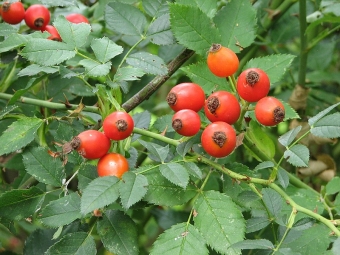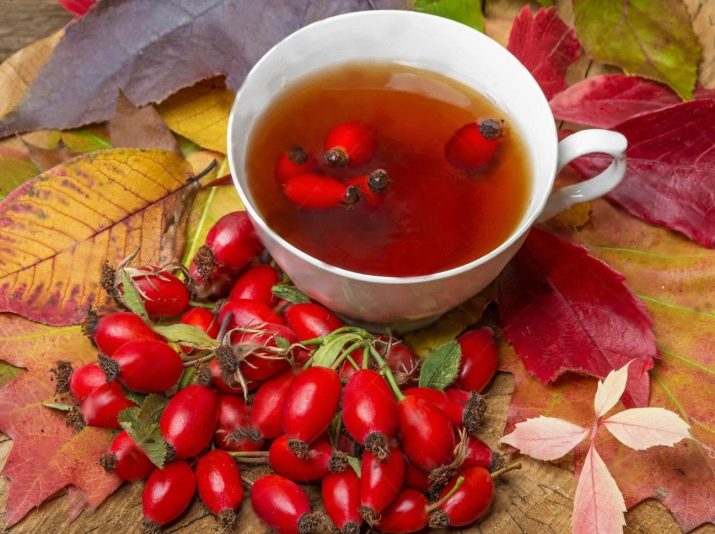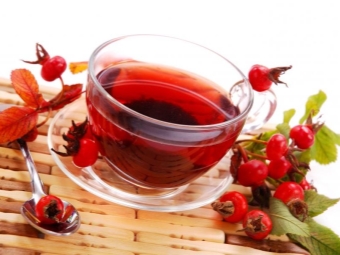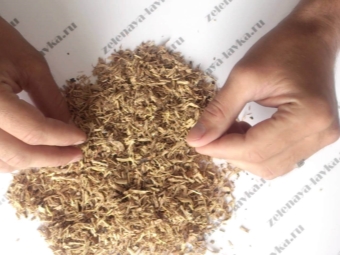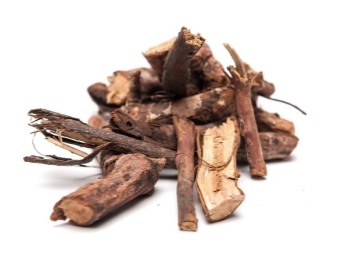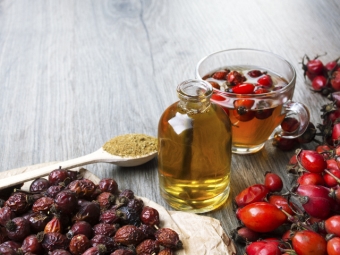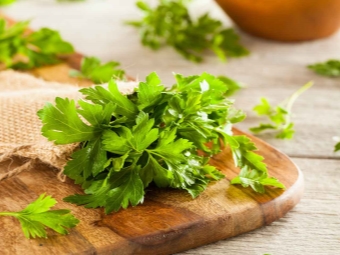Rose Hip: useful properties and contraindications
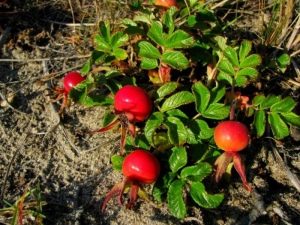
Brier - a small shrub plant, which is a direct descendant of a wild rose.It got its name due to the thorns that are abundantly covered with the trunk and branches of the bush. In the common people, the wild rose is often called “wild rose” or “thorn”. In total in the world there are about four hundred species of this plant, and on the territory of Russia the May variety is the most common. During the reign of Ivan the Terrible, the fruits and leaves of a wild rose were as valuable as sable furs and precious stones.
Collecting hips was allowed only to people who were specifically authorized to do this, and as a reward for their work they received brood or velvet fabric from the king. The berries were kept in the Tsar's storehouses, healers were given out little by little, only for the royal and state needs.
Broths and infusions sorcerers regaled the royal warriors to strengthen their strength.
What?
All parts of a plant - fruits, flower petals, young shoots, leaflets, as well as roots - have useful properties for the human body. Rosehip stabilizes the urinary and reproductive systems, relieves inflammation, improves the functioning of the stomach and intestines, stimulates the body's immune forces, and rejuvenates it. Products made on the basis of wild rose, used to combat pathogens.
This plant is effective in diseases of the heart, blood vessels, hypo or hypertension. It is often taken as a diuretic, choleretic agent for urolithiasis or gallstone disease. Rosehip increases hemoglobin level, regulates metabolic processes, speeds up metabolism.
The most common berries are wild rose berries, but the plant root has equally unique properties that Tibetan healers have unraveled and successfully used. It has been proven by many years of practice that substances contained in the root of a wild rose are capable of dissolving stones in the kidneys and gall bladder - this is its most important property. Wild rose roots contain a large number ascorbic acid, and vitamins of group B, P, PP, E, A, Kbesides, they are rich in minerals - magnesium, iron salts, manganese, zinc, phosphorus. But that is not all! Pectins, tannins, lycopene - this is not the whole list of useful components of wild rose.
Benefits and healing properties
In folk and official medicine tools based on the root of the hips began to use a very long time. Their treatment is effective in such cases as:
- Immunodeficiency states with general weakness in the recovery period after prolonged illness;
- With a low level of hemoglobin, as well as to increase blood clotting with a tendency to hemophilia;
- Rosehip restores normal secretory function in disorders of absorbability and food digestion, stabilizes the bowels during diarrhea, as well as infectious diseases.
- Rosehip taken from stones in the gallbladder with gallstone disease or inflammatory processes in the ducts of the gland;
- The beneficial properties of the root of the plant are used in kidney diseases, especially in urolithiasis and in inflammatory processes;
- Rose effectively helps men with prostatitis, being a natural bactericidal agent. In addition, improves the secretory function of the production of male sex hormones;
- In women, the root of a dog rose successfully treats uterine bleeding;
- Often, with arthritis or arthritis, convulsive syndromes, myalgia and even with rheumatism, doctors prescribe to drink rose hips in combination with anti-inflammatory therapy. Such an interaction greatly enhances the therapeutic effect;
- In hypertension, the root of the dog rose has an expanding blood vessel effect, removing spasms of the vascular walls, thereby reducing blood pressure;
- A decoction of rhizomes of wild rose can cure long-term non-healing ulcers, clean up purulent wounds, promotes rapid regeneration with renewal of the epidermis;
- Broth hips used in metabolic disorders, when there is an uncontrolled weight gain.Rosehip normalizes the balance of hormones, stabilizing weight indicators.
The above properties of the root of a dog rose are manifested if fresh and properly collected raw materials are used for treatment. It is necessary to know and follow some principles that help to get the maximum benefit from the use of this plant.
Harm and contraindications
Rosehip will not harm the human body if you know how to properly apply its properties. There are a number of contraindications in which wild rose preparations should be taken with caution. or for some time to abandon their use completely:
- The presence of diseases associated with impaired blood clotting - thrombosis or thrombophlebitis. Taking drugs from the root of the hips can enhance the process of blood coagulation due to the large content of vitamins C and K;
- If you have gastritis with increased production of hydrochloric acid, or have a stomach ulcer of the stomach or intestines, it is not advisable to take preparations with dogrose;
- Heart diseases, in particular, endocarditis, as well as vascular diseases, require an extremely cautious approach in the appointment of hips, it is not recommended to take it in the acute period of the disease;
- If the tooth enamel is damaged or thinned, the use of rose hips will be difficult, since ascorbic acid will irritate the nerve endings of the teeth, thereby causing pain;
- Hypervitaminosis is an absolute contraindication to the use of rose hips, an excess of ascorbic acid can lead to malfunction of the liver with the development of non-infectious genesis of jaundice;
- In hypertension, alcoholic rosehip tinctures are contraindicated, and in case of hypotension, decoctions with infusions can further lower the level of blood pressure;
- Individual intolerance or allergic reactions, although rarely found on this plant, but if such a factor is present, the use of wild rose preparations will have to be abandoned.
In order for the wild rose to bring health benefits, it is necessary to consult a doctor before using it. This is especially important to do if you decide to take wild rose preparations not to prevent colds or to strengthen the immune system, but to treat serious diseases.
The dosage, method of application, as well as the duration of the course of treatment in this case can only be selected by the doctor, taking into account your condition and those medicines that form the basis of drug therapy.
Harvest time
Wild rose roots can be purchased off-the-shelf at special retail outlets that sell phytopreparations, or they can be prepared for use independently. In order to prepare the root of the wild rose, you need to understand that in order to preserve the plant, it is necessary to cut not the central stem, but only one of its side branches. Harvesting can be carried out twice a year - in the spring before St. George’s Day (May 6), when the bush has not yet bloomed, or in the fall, while all the leaves from the shrub will fall off.
To dig the root is best in dry weather - this will reduce the risk of inflaming the root system of the plant. The roots are washed, divided into small parts and dried in a cool place or in an oven with the door ajar at a temperature not higher than 60 degrees Celsius.
Properly harvesting raw materials is necessary to preserve all its useful properties, but it is equally important to be able to preserve it. After the roots have dried, they are placed in a cardboard box or a fabric bag. Sometimes used waxed paper, lined the bottom of the box or container, where raw materials will be stored, so that moisture does not get there. Storage containers must be clean, dry, and free of odors. Keep packed roots should be stored in a dark cool place at a temperature not exceeding 25 degrees, and it is best if there is free air circulation in the storage place. The shelf life of raw materials is 2.5-3 years.
How to cook?
For the preparation of products from the root of the hips, the raw materials must be of a small fraction, so that it gives better its valuable properties. Many are baffled by the question of how to grind hard roots at home. The easiest way to do this is through a meat grinder. They are poured into a glass jar, using as needed. If necessary, take the next portion of the roots, again grinding them in the same way.
To grind in advance for the future a large amount of raw materials does not make sense, since it is better kept in whole large roots and does not lose its beneficial properties.
Briar roots are prepared for different needs in different ways. Infusion or tincture is made on vodka or alcohol, and decoctions and infusions are prepared on a water basis. Medicine from the root of the hips should be stored away from direct sunlight, since ultraviolet destroys ascorbic acid and other components. Another important condition is that rosehip preparations can not be brewed in metal containers due to the active oxidation process with ascorbic acid. The most suitable dishes can be glass, ceramic or enameled.
Universal recipes:
- Tincture - prepare it at the rate of 1 part of the dry crushed raw materials and 10 parts of vodka or alcohol. Insist this composition for 15 days, then filtered and sealed in bottles of dark glass. The tincture is stored for a long time in a cool place. Take it for diseases of the joints, myalgia, gout;
- Therapeutic bath - one glass of the crushed roots is filled with water at the rate of 2 liters and brought to a boil. Keep on low heat for 15 minutes, then remove and allow to infuse for 2-3 hours. Concentrated and filtered through a sieve decoction is added to the bathroom for taking therapeutic water procedures. The tool relieves muscle spasms, treats pustular rash on the skin, removes slags from the skin, toxins, improves blood circulation, lymph, and also perfectly tones and invigorates the body;
- Decoction - Take two tablespoons of chopped root, pour a glass of water, and then boil the composition for no more than one minute from the moment of boiling. Then give it to brew until cool. Strain the resulting drink best before use, so it is better to retain all its beneficial properties. It is used for urolithiasis, gallbladder stones, diarrhea, and intestinal infections.
Recipes for men:
- With prostate stones. They take three tablespoons of crushed hips, pour boiling water over them, boiling for 30 minutes in a water bath with the lid closed. Then the container is placed in a warm place and allowed to drink for at least 6 hours. The cooled broth is filtered, and then taken in half a glass 4 times daily. The course is designed for four weeks of admission, then, if necessary, after a month break, it can be repeated. As a result of treatment, cutting and nagging pains of the lower abdomen pass;
- To improve potency. Two tablespoons of parsley seeds and rosehips are ground to a powder. A glass of honey in May is added to warmed red grape wine and crushed ingredients are added to the composition. Mix the mixture well, then leave it to infuse for 3 weeks in a dark glass container, shaking daily. Filtered means taken three times a day for an hour before meals;
- To extend the time of onset of ejaculation - take in accordance with the proportion of 2: 1 rosehip leaves and motherwort with calendula and melissa. Add 1.5 liters of water to the collection and bring to a boil over low heat in a water bath. Cooking time should not exceed 30 minutes. After cooling the drink, strain and consume twice daily, 100 milliliters. The composition normalizes the potency and increases the duration of sexual intercourse.
Recipes for women:
- With uterine bleeding. Two tablespoons of the roots of wild rose chop, pour half a liter of water, bring to a boil. Broth after a 15-minute low-heat boil for about three hours. Then it is filtered and taken in half a glass 3 times a day one hour before meals;
- Slimming drink. 100 grams of roots brew in a thermos with a glass bulb at the rate of 1 liter. Leave to infuse for 8-10 hours, then strain. Take a drink an hour after each meal;
- For the treatment of fungal infections. Mix 500 milliliters of vodka and two tablespoons of crushed roots. Let it stand in a dark place for 10 days, filter, take a tablespoon half an hour before meals.
Products made from wild rose roots are most effective when taken immediately after preparation.
In the air, ascorbic acid and other vitamins tend to oxidize, which means that the more time passes from the moment of readiness for the use of the drug, the less useful it becomes.
Reviews and recommendations
According to numerous reviews of qualified specialists in the field of urology, andrology, gynecology and other specializations, as well as based on the mass of responses about the results of treatment left by patients on social networks, it can be concluded that the preparations prepared on the basis of the dogrose root have active biological action and are effective in treating many serious diseases.
Thanks to this plant raw material, salt conglomerates in the form of sand and small deposits (stones) that have formed in the kidneys are successfully excreted from the body. Patients suffering from gallstone disease, who have been treated with infusions of wild rose roots, have significantly improved the flow of bile to the duodenal ducts, as a result of which the digestion process has normalized.
Quite a large number of responses are in women's forums from patients, which rose hips helped with painful and abundant menragia.
Doctors recommend their patients to pay attention to this natural medicinal material and use it to restore their health. However, before you begin taking medications, you need to agree on the dosage and frequency of use with specialists.
How to remove stones from the gallbladder, see the following video.

